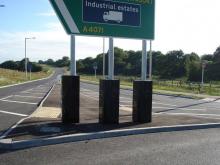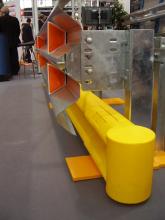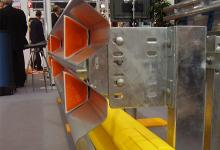The European Commission is proposing that part of its controversial new Anti-Tampering regulations for motorcycles should be re-written to prevent custom motorcycle builders from using long-forks. This is the latest in a series of requirements in the regulations to attracted criticisms from motorcycle manufacturers, dealers, safety campaigners and enthusiasts groups.

The 2465 European Commission is proposing that part of its controversial new Anti-Tampering regulations for motorcycles should be re-written to prevent custom motorcycle builders from using long-forks. This is the latest in a series of requirements in the regulations to attracted criticisms from motorcycle manufacturers, dealers, safety campaigners and enthusiasts groups. The Anti-Tampering regulations are intended to boost rider safety and reduce the annual toll of deaths and injuries amongst motorcycle riders across Europe. However there is no evidence that any of the proposed measures will have any effect on boosting safety. And barrier safety measures that have been proven to boost motorcyclist safety in Spain, are being blocked as requirements across the 27 EU nations.
The European Commission is proposing that any bikes being put through the Individual Vehicle Approval test (the safety inspection made before non Type-Approved imports), one-off specials, (currently known as Motorcycle Single Vehicle Approval) would have to complete a slalom and U-Turn before being registered, to prevent modifications to the length of the forks. Up to now, the draft regulations have only talked about requiring manufacturers to design the engine, transmission, final-drive and rear tyre dimension so that it becomes difficult for owners to modify them from standard.
The UK representatives in the technical discussions have joined with the Federation of European Motorcycle Associations (2906 Fema) and others in opposing the proposal. The reason is that the European Commission cannot produce any evidence to show that modified bikes are unsafe.
In addition, the European Commission is expected to continue to seek further restrictions on the ability to modify bikes in future, despite mounting criticism that it has failed to consider whether there is any demonstrable case that these would boost safety.
The UK’s6434 Motorcycle Action Group (MAG) had previously warned that the vagueness of the Commission's proposals to restrict modifications could mean the ambitions of those who want to save rider’s lives might extend beyond the draft proposals that have been under discussion since 2010. The MAG says that the latest amendment wishes to measure/control steerability, cornering properties and turn ability. This development forms part of the technical specifics designed to accompany the regulation. As yet the regulation has two more stages to pass through; The Council (National Governments) and the full EU Parliament.
The6435 European Twowheel Retailers' Association (ETRA) recently said, "If the current text of article 18 is adopted by the European Parliament and the Council, all usual changes asked by motorcyclists to their garages for either riding comfort, fuel efficiency, or to suit their style and taste, will be illegal or will have to be checked and approved, thus making motorcycling more expensive and servicing more burdensome. As regards article 52 on System components and separate technical units, the report has left the current text practically unchanged. Once again we want to express our concerns on the negative effects it can have on the sales and service sector, such as preventing the sale of all systems, components or separate technical units which have dual use, in other words which are used for both sport activities (not taking place on public roads) and for road use.”
Neither dealers nor manufacturers are keen on this proposed framework. ACEM (the6436 Association of European Manufacturers) said the move would translate into added costs due to more stringent environmental and safety measures. This applies in particular to light motorcycles and scooters of the 125cc class, which form the core of the EU’s ailing market and provide urban mobility and social cohesion benefits to citizens. This is recognised by the panel of experts intended to deal with the technical issues for the European Commission, IMCO, in its report. For this category of motorcycles, ACEM regrets that safe advanced braking systems alternatives to ABS such as Combined Braking Systems have been scrapped from the available safety measures, effectively wiping out years of investments in research and development. IMCO has so far managed to bungle each stage of the process, suggesting that it is unaware of the problems that the vagueness of the proposed regulations could cause, or the cost.
ABS has its benefits indeed but in a motorcycle application, linked brakes offer many of the same advantages and (arguably) some more as well, as well as at far lower cost to install and service. Loss of control is a factor quoted as the cause of many motorcycle accidents, however these reports rarely specify the cause. Loss of control in a motorbike can be down to many different reasons, such as a diesel spill, a pothole or a blowout, things that those bureaucrats with only armchair experience of motorcycles would not appreciate.
By comparison, turning circles have never been considered a sufficient problem to require legislation with other motor vehicles. For example, four-wheel-drive vehicles typically have larger turning circles than two-wheel-drive vehicles, but this is not considered a safety issue.
As the current proposals stand, the most direct safety benefit these will have to reducing powered two wheeler accidents would be through dissuading riders from using these vehicles due to increased ownership costs. The proposals have no other proven benefits to rider safety. And with Europe’s roads becoming increasingly clogged with traffic, it is clear that powered two wheelers should have a future as part of the answer rather than the problem. It is a bitter irony that some of those most intent on pushing through the much criticised Anti-Tampering legislation are simultaneously resisting the wider introduction of the Spanish safety barrier regulations across Europe. In other words, while focussing on an expensive process with no demonstrable benefits to the safety of powered two wheeler users, they are blocking the wider introduction of proven technologies that will save lives and reduce the incidence of crippling injuries amongst riders. Similarly, there are effective, low-cost warning devices that could be installed on all new cars, vans, buses and trucks to alert the driver when the vehicle is in proximity with a vulnerable road user, such as a motorcyclist, cyclist or pedestrian. These are inexpensive and are already approved for use and would help tackle one of the major causes of powered two wheeler accidents, in which the drivers of other vehicles do not look properly before making a manoeuvre. They could be required to be fitted to all new vehicles, with a phased introduction then across all existing vehicles over a period of years. However this proven technology is also not on the agenda for reasons that are unclear.
The European Commission has a poor record on addressing motorcycle safety. In the early 1990s a commissioner pushed through power restrictions for motorcycles, despite the lack of any evidence that there was a correlation between motorcycle power output and incidences of accidents. Some countries adopted these restrictions, while others did not but the power limitations made no apparent difference to instances of motorcycle accidents. When the power restrictions were subsequently dropped in those countries where they had been implemented, there was no demonstrable increase in the accident rate.
Requirements that could be introduced to boost safety for motorcyclists have meanwhile been stalled. Evidence shows that current European standard guardrails are not safe for motorcyclists. The European Parliament’s own initiative report on European Road Safety the European Parliament clearly identifies European standard guardrails as "death traps" for motorcyclists.
Where trucks and cars are being prevented from colliding with oncoming traffic or from leaving the road falling motorcyclists face sharp-edged metal posts. The consequences of a guardrail accident are likely to be severe or fatal. For years FEMA has been campaigning for a new standard which takes crash tests with motorcycles into account. The European Committee for Standardisation (CEN) looked at the issue but European countries could not agree on a new standard, even though fully tested concepts are available.
While the Part 8 is not officially incorporated as a standard, the members of the CEN have approved it as a technical specification (TS). The difference between a TS and EN is that its application is voluntary. In principle, Member States can ask manufacturers to comply with these requirements. The reality is that for the countries against this norm, nothing will actually change. Even if the Part 8 were fully integrated into a norm, it would still require member states to define the criteria for the installation of barrier technology that is safer for motorcyclists, and many countries do not have such requirements. To move things forward, it would be necessary for national governments to adopt national guidelines so that manufacturers also have a clearer idea of what is required of them.
The Anti-Tampering legislation suggests that the European Commission is still unable to understand the problems the proposals will cause, or for that matter the real issues regarding the safety of Europe’s powered two wheeler riders. With various studies having shown that on average some 65% of powered two wheeler accidents are not the fault of the rider and with other road users being the biggest single cause of such accidents, quite what the proponents of the Anti-Tampering legislation expect to achieve is also unclear. The panel of experts brought in to advise on the various issues have so far managed to add to the confusion and the competence of the officials dealing with the legislation has to be called into question. Bodies that understand the issues surrounding motorcycling such as ACEM, ETRA, FEMA and the MAG have all pointed out the various problems but the bureaucrats do not appear to be listening and quite why this should be so is not immediately apparent. In the mean time, the fatality rate amongst motorcyclists across Europe continues to cause concern, with many of those deaths being preventable using available technology developed for the Spanish market, while at the same time the main focus on hugely expensive regulation changes intended to tackle motorcycle safety which will offer limited safety benefits overall.
The European Commission is proposing that any bikes being put through the Individual Vehicle Approval test (the safety inspection made before non Type-Approved imports), one-off specials, (currently known as Motorcycle Single Vehicle Approval) would have to complete a slalom and U-Turn before being registered, to prevent modifications to the length of the forks. Up to now, the draft regulations have only talked about requiring manufacturers to design the engine, transmission, final-drive and rear tyre dimension so that it becomes difficult for owners to modify them from standard.
The UK representatives in the technical discussions have joined with the Federation of European Motorcycle Associations (
In addition, the European Commission is expected to continue to seek further restrictions on the ability to modify bikes in future, despite mounting criticism that it has failed to consider whether there is any demonstrable case that these would boost safety.
The UK’s
The
Neither dealers nor manufacturers are keen on this proposed framework. ACEM (the
ABS has its benefits indeed but in a motorcycle application, linked brakes offer many of the same advantages and (arguably) some more as well, as well as at far lower cost to install and service. Loss of control is a factor quoted as the cause of many motorcycle accidents, however these reports rarely specify the cause. Loss of control in a motorbike can be down to many different reasons, such as a diesel spill, a pothole or a blowout, things that those bureaucrats with only armchair experience of motorcycles would not appreciate.
By comparison, turning circles have never been considered a sufficient problem to require legislation with other motor vehicles. For example, four-wheel-drive vehicles typically have larger turning circles than two-wheel-drive vehicles, but this is not considered a safety issue.
As the current proposals stand, the most direct safety benefit these will have to reducing powered two wheeler accidents would be through dissuading riders from using these vehicles due to increased ownership costs. The proposals have no other proven benefits to rider safety. And with Europe’s roads becoming increasingly clogged with traffic, it is clear that powered two wheelers should have a future as part of the answer rather than the problem. It is a bitter irony that some of those most intent on pushing through the much criticised Anti-Tampering legislation are simultaneously resisting the wider introduction of the Spanish safety barrier regulations across Europe. In other words, while focussing on an expensive process with no demonstrable benefits to the safety of powered two wheeler users, they are blocking the wider introduction of proven technologies that will save lives and reduce the incidence of crippling injuries amongst riders. Similarly, there are effective, low-cost warning devices that could be installed on all new cars, vans, buses and trucks to alert the driver when the vehicle is in proximity with a vulnerable road user, such as a motorcyclist, cyclist or pedestrian. These are inexpensive and are already approved for use and would help tackle one of the major causes of powered two wheeler accidents, in which the drivers of other vehicles do not look properly before making a manoeuvre. They could be required to be fitted to all new vehicles, with a phased introduction then across all existing vehicles over a period of years. However this proven technology is also not on the agenda for reasons that are unclear.
The European Commission has a poor record on addressing motorcycle safety. In the early 1990s a commissioner pushed through power restrictions for motorcycles, despite the lack of any evidence that there was a correlation between motorcycle power output and incidences of accidents. Some countries adopted these restrictions, while others did not but the power limitations made no apparent difference to instances of motorcycle accidents. When the power restrictions were subsequently dropped in those countries where they had been implemented, there was no demonstrable increase in the accident rate.
Requirements that could be introduced to boost safety for motorcyclists have meanwhile been stalled. Evidence shows that current European standard guardrails are not safe for motorcyclists. The European Parliament’s own initiative report on European Road Safety the European Parliament clearly identifies European standard guardrails as "death traps" for motorcyclists.
Where trucks and cars are being prevented from colliding with oncoming traffic or from leaving the road falling motorcyclists face sharp-edged metal posts. The consequences of a guardrail accident are likely to be severe or fatal. For years FEMA has been campaigning for a new standard which takes crash tests with motorcycles into account. The European Committee for Standardisation (CEN) looked at the issue but European countries could not agree on a new standard, even though fully tested concepts are available.
While the Part 8 is not officially incorporated as a standard, the members of the CEN have approved it as a technical specification (TS). The difference between a TS and EN is that its application is voluntary. In principle, Member States can ask manufacturers to comply with these requirements. The reality is that for the countries against this norm, nothing will actually change. Even if the Part 8 were fully integrated into a norm, it would still require member states to define the criteria for the installation of barrier technology that is safer for motorcyclists, and many countries do not have such requirements. To move things forward, it would be necessary for national governments to adopt national guidelines so that manufacturers also have a clearer idea of what is required of them.
The Anti-Tampering legislation suggests that the European Commission is still unable to understand the problems the proposals will cause, or for that matter the real issues regarding the safety of Europe’s powered two wheeler riders. With various studies having shown that on average some 65% of powered two wheeler accidents are not the fault of the rider and with other road users being the biggest single cause of such accidents, quite what the proponents of the Anti-Tampering legislation expect to achieve is also unclear. The panel of experts brought in to advise on the various issues have so far managed to add to the confusion and the competence of the officials dealing with the legislation has to be called into question. Bodies that understand the issues surrounding motorcycling such as ACEM, ETRA, FEMA and the MAG have all pointed out the various problems but the bureaucrats do not appear to be listening and quite why this should be so is not immediately apparent. In the mean time, the fatality rate amongst motorcyclists across Europe continues to cause concern, with many of those deaths being preventable using available technology developed for the Spanish market, while at the same time the main focus on hugely expensive regulation changes intended to tackle motorcycle safety which will offer limited safety benefits overall.







